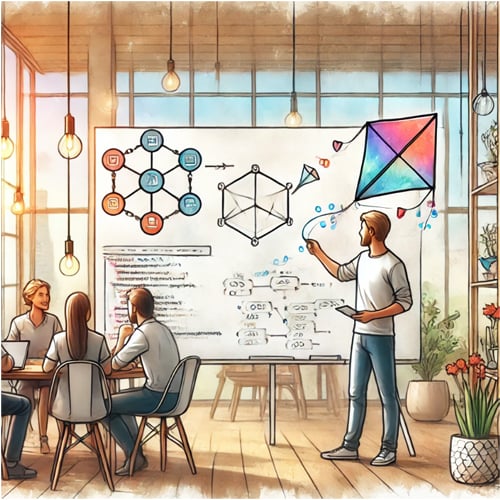🪁 Why analogies are your secret weapon for clear communication

Hello Hello!
Have you ever tried to explain something to a child and realized—halfway through—that you’ve gone way too deep? That’s exactly what many of us do when we try to explain things, especially in tech.
We know the systems so well that we unconsciously assume others need (and want) to understand them at the same level. But most people don’t need all the technical layers—we just overwhelm them and lose their attention.
That’s why we need to simplify. One of the most powerful ways to do that? Analogies.
When I teach arrays to my COMP100 students, I don’t jump into syntax or memory management. I show them a row of mailboxes—each one holding a different letter. Simple, visual, and relatable. (It works! What do you think? 🙂)
Today, let’s talk about how using analogies can help your ideas stick—especially when your audience isn’t technical.
Enjoy,
— Aderson
🪁 Why analogies are your secret weapon for clear communication
Ever explain something and see the other person’s eyes glaze over? That’s your sign: you’ve gone too deep, too fast, and probably lost them in the jargon. So what do you do when your audience isn’t technical, but your message is?
You bring out the kite.
Analogies are like kites: they lift complex ideas up into the air, making them visible, light, and easy to follow. Today, we’re going to talk about how you can use analogies to explain your work in a way that actually sticks.
🧩 Three keys to using analogies effectively:
🍞 Pick Analogies from Everyday Life
🧃 Anchor the Analogy Before Adding Layers
🪄 Use Analogies to De-Jargonize the Room
🍞 1. Pick Analogies from Everyday Life
Don’t overthink it. Analogies don’t need to be clever—they need to click. The best ones come from your own daily experience: cooking, commuting, building IKEA furniture, parenting, dating, or fixing something with duct tape.
Imagine you’re explaining how APIs work. Instead of saying “it’s a contract between services,” say: “It’s like a restaurant. You (the user) look at a menu (the API), place your order (the request), and the kitchen (the server) gives you your food (the response). You don’t need to know how the kitchen operates—you just need your meal.”
The beauty of analogies like this? People remember them. And once they remember, they repeat them—giving your explanation staying power.
So when in doubt, simplify. Think of how you’d explain it to your mom, your teenage cousin, or your neighbor who isn’t in tech. If it makes them nod, it’ll make your audience nod too.
🧃 2. Anchor the Analogy Before Adding Layers
A big mistake is rushing. You throw out an analogy and immediately jump into jargon right after. That kills the effect. Let the analogy sink in first. Give it a moment. Anchor it.
Once your audience connects with the first layer, you can start building. Using the restaurant analogy again, once the audience gets that APIs are like ordering food, then you can say: “In this case, the app we’re building is the waiter. It talks to different kitchens to get what you need—whether that’s pulling up your profile info or saving a payment.”
This two-step flow builds understanding naturally. It’s like teaching someone how to ride a bike. You don’t start on hills. You start with balance.
Anchor → Relate → Expand.
🪄 3. Use Analogies to De-Jargonize the Room
Sometimes you’re the only one in the room who understands the tech. And that’s okay—as long as you don’t sound like you’re auditioning for a scene in The Matrix.
People get turned off by what they don’t understand. They won’t stop you—they’ll just tune out. That’s why analogies are your secret weapon to keep people in the conversation.
Let’s say you’re talking about technical debt. You could say: “It’s like ignoring a leaky roof. The longer you wait to fix it, the more damage it does—and the more expensive it gets.” Now everyone in that meeting suddenly gets what technical debt is, even if they’ve never written a line of code.
Analogies are not about dumbing things down—they’re about opening doors. They make you sound inclusive, relatable, and clear. And that earns you trust.
Final Thoughts
Using analogies is not about sounding smart—it’s about being understood. And when people understand you, they trust you more. They see you as clear, thoughtful, and—most importantly—someone they want to work with.
“The single biggest problem in communication is the illusion that it has taken place.” — George Bernard Shaw